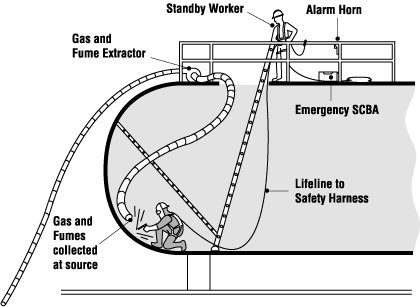Thursday, November 18, 2010
Forced Ventilation
When a hazardous atmosphere is present or potentially present, forced ventilation is used before entry and sometimes during entry in order to preserve a natural breathing environment. This is sometimes used in addition to SCBA's (self contained breathing apparatus's).
Hazardous atmosphere's can include oxygen deficient and oxygen rich atmosphere's as well as toxic atmospheres resulting from chemical vapors.
Forced ventilation devices similar to the one pictured above are placed into the confined space before entry and allowed to ventilate the space until the safety attendant records permissable oxygen levels using a O2 monitor. During entry, oxygen levels are continually monitored by the entry attendant and if levels become hazardous the entry is aborted and the entrant must come out.
For more information visit the following link:
http://www.ehss.vt.edu/programs/CNF_forced_air_entry.php
Hazardous atmosphere's can include oxygen deficient and oxygen rich atmosphere's as well as toxic atmospheres resulting from chemical vapors.
Forced ventilation devices similar to the one pictured above are placed into the confined space before entry and allowed to ventilate the space until the safety attendant records permissable oxygen levels using a O2 monitor. During entry, oxygen levels are continually monitored by the entry attendant and if levels become hazardous the entry is aborted and the entrant must come out.
For more information visit the following link:
http://www.ehss.vt.edu/programs/CNF_forced_air_entry.php
Fall Protection Harnesses in Confined Space Entry
Fall protection harnesses are used in most confined space entry situations to protect against falls as well as a rescue line to help remove the entrant should an emergency occur.
Fall protection harnesses should be maintained and inspected by the entrant before each and every entry with no exceptions. If a harness has wear and the potential to fail it should not be used under any circumstances, because what is the point of even wearing it it it fails when it is needed in an emergency situation.
Entrants should be trained before entry on the proper way to wear their harness and how to inspect them before each use. Training records should be maintained on yearly training and inspection of harnesses and most definitely be maintained on the documentation of each entry and atmospheric levels as well.
Fall protection harnesses should be maintained and inspected by the entrant before each and every entry with no exceptions. If a harness has wear and the potential to fail it should not be used under any circumstances, because what is the point of even wearing it it it fails when it is needed in an emergency situation.
Entrants should be trained before entry on the proper way to wear their harness and how to inspect them before each use. Training records should be maintained on yearly training and inspection of harnesses and most definitely be maintained on the documentation of each entry and atmospheric levels as well.
Subscribe to:
Posts (Atom)




